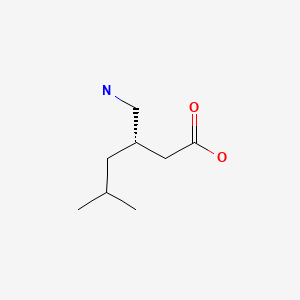Attribution Statement: LactMed is a registered trademark of the U.S. Department of Health and Human Services.
NCBI Bookshelf. A service of the National Library of Medicine, National Institutes of Health.
Drugs and Lactation Database (LactMed®) [Internet]. Bethesda (MD): National Institute of Child Health and Human Development; 2006-.
CASRN: 148553-50-8

Drug Levels and Effects
Summary of Use during Lactation
Limited data indicate that amounts of pregabalin in breastmilk are low and one infant breastfed for 3 months with no discernable adverse effects. If pregabalin is required by the mother of an older infant, it is not a reason to discontinue breastfeeding, but until more data become available, an alternate drug may be preferred, especially while nursing a newborn or preterm infant. The manufacturer recommends that breastfeeding is not recommended during treatment with pregabalin because of the potential risk of tumorigenicity based on high-dose animal studies over a prolonged period. Pregabalin has been used to treat persistent nipple pain in a few women at an average starting dosage of 100 mg daily.[1]
Drug Levels
In published reports of anticonvulsant use during breastfeeding, most women were taking a combination of anticonvulsants. Some other anticonvulsants (e.g., phenytoin, carbamazepine) stimulate the metabolism of other drugs including anticonvulsants, whereas others (e.g., valproic acid) inhibit the metabolism of other drugs. Therefore, the relationship of the maternal dosage to the concentration in breastmilk can be quite variable, making calculation of the weight-adjusted percentage of maternal dosage less meaningful than for other drugs in this database
Maternal Levels. In one woman, the breastmilk pregabalin level was about equal to the maternal serum concentration.[2]
Ten women who averaged 35.6 weeks postpartum (range 20 to 43 weeks) were given pregabalin 150 mg every 12 hours for 4 doses. Milk samples were obtained before the last dose and 5 times during the 24 hours after the last dose. Three additional collections were made between 24 and 48 hours after the last dose in 5 of the subjects. The average peak breastmilk pregabalin concentration was 4.63 mg/L and the average breastmilk pregabalin concentration was 2.05 mg/L. The average daily infant dosage was 0.31 mg/kg, or about 7% of the maternal weight-adjusted dosage.[3]
Infant Levels. The breastfed infant of a woman who was taking pregabalin (dose not specified) as an anticonvulsant during pregnancy and breastfeeding had a pregabalin serum concentration of 429 mcg/L at 48 hours postpartum, which was about 8% of the mother's serum concentration. Some of the infant's serum concentration could have been derived from transplacental passage, because the pregabalin half-life in this and another newborn averaged 17 hours.[2]
Effects in Breastfed Infants
A nursing mother with Raynaud’s phenomenon of the nipple was taking nifedipine, which resolved the nipple blanching, but not the lancing pain in the breast that occurred several times daily. Pregabalin 75 mg twice daily was added which almost completely resolved the pain. Her infant was exclusively breastfed for 3 months and experienced no adverse effects.[4]
Effects on Lactation and Breastmilk
A study randomized pregnant women to either a single dose of pregabalin 150 mg (n = 45), 300 mg (n = 45), or placebo (n = 45) orally 1 hour before induction of anesthesia for an elective cesarean section to reduce postoperative analgesia requirements. Three infants of mothers in the pregabalin 300 mg group had difficulty latching on for breastfeeding for 8 hours after delivery although none were sedated.[5]
Alternate Drugs to Consider
(Neuropathic Pain) Carbamazepine, Gabapentin; (Seizure Disorder) Carbamazepine, Divalproex, Gabapentin, Lamotrigine, Oxcarbazepine, Phenytoin, Valproic Acid
References
- 1.
- Faraoni L, Delfino E, Notarangelo M, et al. Pregabalin for persistent lactating breast pain: A case series. Breastfeed Med. 2023;18:A19–A20. [CrossRef]
- 2.
- Öhman I, De Flon P, Tomson T. Pregabalin kinetics in the neonatal period, and during lactation. Epilepsia. 2011;52 Suppl 6:249–50. [CrossRef]
- 3.
- Lockwood PA, Pauer L, Scavone JM, et al. The pharmacokinetics of pregabalin in breast milk, plasma, and urine of healthy postpartum women. J Hum Lact. 2016;32:NP1–NP8. [PubMed: 26961752]
- 4.
- Gallego H, Aleshaki JS. Raynaud phenomenon of the nipple successfully treated with nifedipine and gabapentin. Cutis. 2020;105:e22–e23. [PubMed: 32717000]
- 5.
- El Kenany S, El Tahan MR. Effect of preoperative pregabalin on post-caesarean delivery analgesia: A dose-response study. Int J Obstet Anesth. 2016;26:24–31. [PubMed: 26718698]
Substance Identification
Substance Name
Pregabalin
CAS Registry Number
148553-50-8
Disclaimer: Information presented in this database is not meant as a substitute for professional judgment. You should consult your healthcare provider for breastfeeding advice related to your particular situation. The U.S. government does not warrant or assume any liability or responsibility for the accuracy or completeness of the information on this Site.
- User and Medical Advice Disclaimer
- Drugs and Lactation Database (LactMed) - Record Format
- LactMed - Database Creation and Peer Review Process
- Fact Sheet. Drugs and Lactation Database (LactMed)
- Drugs and Lactation Database (LactMed) - Glossary
- LactMed Selected References
- Drugs and Lactation Database (LactMed) - About Dietary Supplements
- Breastfeeding Links
- PubChem SubstanceRelated PubChem Substances
- PubMedLinks to PubMed
- Review Atomoxetine.[Drugs and Lactation Database (...]Review Atomoxetine.. Drugs and Lactation Database (LactMed®). 2006
- Review Linezolid.[Drugs and Lactation Database (...]Review Linezolid.. Drugs and Lactation Database (LactMed®). 2006
- Review Tranexamic Acid.[Drugs and Lactation Database (...]Review Tranexamic Acid.. Drugs and Lactation Database (LactMed®). 2006
- Review Almotriptan.[Drugs and Lactation Database (...]Review Almotriptan.. Drugs and Lactation Database (LactMed®). 2006
- Review Ezogabine.[Drugs and Lactation Database (...]Review Ezogabine.. Drugs and Lactation Database (LactMed®). 2006
- Pregabalin - Drugs and Lactation Database (LactMed®)Pregabalin - Drugs and Lactation Database (LactMed®)
Your browsing activity is empty.
Activity recording is turned off.
See more...
